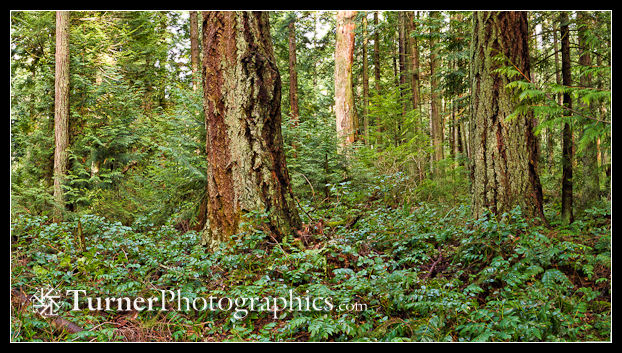Fragrance Forest Panoramas
I continue to be drawn to Chuckanut Mountain trails for my winter hikes. Last weekend I headed up the Fragrance Lake Trail from Larrabee State Park. There’s a lookout over the bay just over a mile from the trailhead and Fragrance Lake itself is only about 2.2 miles with less than 1000 feet of elevation gain. I carried my Canon G12 pocket camera and a small tripod.

I brought the tripod, a relatively lightweight model I purchased last year just for my little camera, so I could work with long exposures in the dark forest and create stitched panoramas. The “Merge to Panorama” function in Photoshop has gotten very good. I’ve used it with images from my big DSLRs and wanted to see what I could come up with from my pocket camera.
The forest scene above, which is along the side trail to the overlook, was composed of five original frames. When shooting to build a panorama there are a few important technical details to get right:
- Use manual exposure. You don’t want your camera changing the exposure from frame to frame. If exposures are different they won’t merge together well.
- Use a relatively small aperture. This gives greater depth of field and more sharpness.
- Keep the camera level. You’ll have more distortion if the camera is tipped up or down. Level horizontally so the horizon doesn’t run downhill.
- Overlap adjacent frames about 1/3. This gives the software more to work to line up the pieces and also helps reduce distortion.
I also used the self-timer to trigger the shutter so I wouldn’t shake the camera, even with it on a tripod, when pressing the shutter release button. Each exposure was 1/3 second. A panning head works better than a ballhead, and to be technically correct the axis of rotation should match the center of the lens.

For this panorama, made from the side of the trail near the junction of the spurs leading to Fragrance Lake and to the old road, I turned the camera vertical. Like the first image, I used the widest zoom setting to include as much of the landscape in each frame as possible. This is a six-frame panorama. The ghostly green hue comes from a thin layer of lichens on the trunks of the Western Redcedars and the green light filtering through all the foliage overhead.

I used a similar technique to create this photograph of the forest reflected in the glassy surface of Fragrance Lake, but instead of panning horizontally I made two exposures one above the other. Then I made another exposure of the sky to record the detail in the clouds, which were overexposed in the frames of the forest and lake. I composited the pieces manually in Photoshop, using a layer mask to reveal the darker sky.
All three of these photos were also processed in Topaz Adjust 5 to bring out some details and enhance the color.

